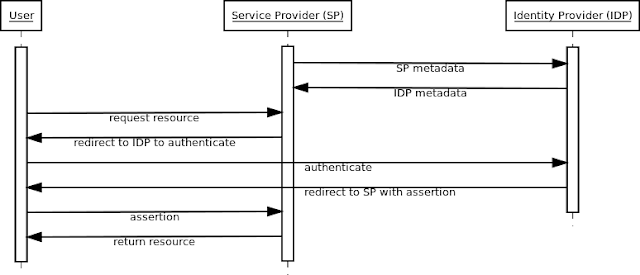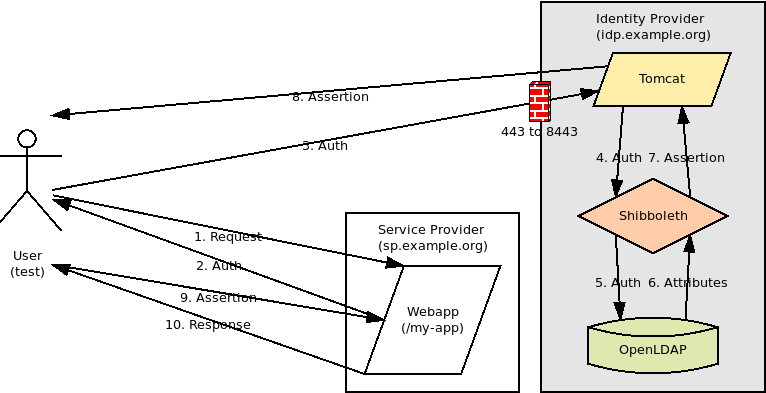Authentication in the Cloud using SAML
What is SAML?
A solution for implementing this requirement is using the SAML authentication protocol to delegate user authentication in each application or service provider (SP) to a trusted third party system called an identity provider (IDP). The typical SAML authentication process is initiated when a user requests a protected resource from any of the organization’s applications (service providers). If the user is not authenticated, the service provider sends the user to the identity provider to authenticate. After the user successfully authenticates, the identity provider sends the user back to the service provider with a signed SAML assertion containing a set of attributes it knows about the user such as an user identifier and email address. When the service provider receives the SAML assertion, it verifies the signature on the SAML assertion to ensure it came from the identity provider and was not tampered with in transit. This verification is done using the identity provider’s public signing key. If the signature is valid, the service provider finds the attribute from the SAML assertion identifying the user (username, email, etc) and returns the requested resource if it determines that the user is authorized to access it. The specific endpoint locations (URLs) on the identity provider and service provider that the user is sent to and keys used in this process are typically specified in metadata files that are exchanged between the identity and service providers during the initialization of both entities. Since the user and messages are sent between these entities using HTTP redirects, this particular flow is referred to as the HTTP Redirect binding in SAML.
 |
| SAML HTTP Redirect Binding |
Another common binding is the HTTP POST binding, which uses JavaScript triggered HTML form submissions to send messages via HTTP POST. It is possible for SAML message exchanges to use both HTTP Redirect and HTTP POST bindings in cases where the former cannot be used due to message length exceeding the maximum allowable URL length of a browser. For example, if the SAML assertion returned from the identity provider contains many attributes, the SAML message exchange may use the redirect binding for the initial SAML authentication request, but POST binding for SAML response.
There are many good SAML identity providers available as a service in the cloud to choose from. The setup is similar across all of them and typically involves two steps. First, to authenticate the organization’s users, the identity provider needs to know who the users are. This is typically done by connecting the identity provider to the organization’s user database such as a directory server (LDAP, Active Directory, etc). Second, for each application delegating to the identity provider for authentication, the identity provider needs to know where (callback URL) on each application to send the user and SAML assertion after the user successfully authenticates.
Each application acting as a SAML service provider needs to perform two actions in the SAML authentication process. First, it needs to send unauthenticated users to the identity provider to authenticate. Second, it needs to parse and validate the SAML assertion that is sent back to it after the user successfully authenticates to the identity provider. In this post, I will demonstrate how to do the latter using the OpenSAML 3 Java library.
Working with SAML Metadata
To validate the signature on the SAML assertion from the identity provider, the service provider needs to get the identity provider’s public signing key. The service provider can get this signing key from the identity provider’s metadata.
 |
| Example IDP Metadata XML |
SAML metadata can contain one or more entity descriptors, each identified by an entity ID. Each entity descriptor contains one or more role descriptors for each role the entity performs. Typically, an identity provider’s metadata file will contain only one entity descriptor (<EntityDescriptor>) containing one role descriptor describing the identity provider (<IDPSSODescriptor>) including its keys and endpoints. Each service provider needs to be configured with the entity ID of the identity provider it is using.
 |
| OpenSAML 3 classes for resolving metadata and credentials |
The MetadataCredentialResolver class can be used to get the keys (Credential) from metadata for an entity based a set of Criterion (CriteriaSet) such as its role (IDPSSODescriptor) and entity ID. The resolve method of MetadataCredentialResolver returns all Credentials for the identity provider so the service provider needs to iterate through and find the one used for signing.
MetadataCredentialResolver credentialResolver = new MetadataCredentialResolver();
credentialResolver.setRoleDescriptorResolver(roleDescriptorResolver);
credentialResolver.setKeyInfoCredentialResolver(DefaultSecurityConfigurationBootstrap.buildBasicInlineKeyInfoCredentialResolver());
credentialResolver.initialize();
CriteriaSet criteriaSet = new CriteriaSet();
criteriaSet.add(new EntityIdCriterion("urn:my-idp"));
criteriaSet.add(new EntityRoleCriterion(IDPSSODescriptor.DEFAULT_ELEMENT_NAME));
Credential signingKey = null;
Iterator<Credential> it = credentialResolver.resolve(criteriaSet).iterator();
while (it.hasNext()) {
Credential key = it.next();
if (key.getUsageType() == UsageType.SIGNING) {
signingKey = key;
}
}
MetadataCredentialResolver uses an instance of BasicRoleDescriptorResolver to resolve role descriptors for a given entity.
BasicRoleDescriptorResolver roleDescriptorResolver = new BasicRoleDescriptorResolver(metadataResolver);
roleDescriptorResolver.initialize();
BasicRoleDescriptorResolver uses an implementation of the MetadataResolver interface to resolve entity descriptors. In this demo, HTTPMetadataResolver is used, which uses a HttpClient to get the metadata from an URL.
HttpClientBuilder builder = new HttpClientBuilder();
HttpClient client = builder.buildClient();
HTTPMetadataResolver metadataResolver = new HTTPMetadataResolver(client, "https://my-idp/metadata");
metadataResolver.setRequireValidMetadata(true);
metadataResolver.setParserPool(XMLObjectProviderRegistrySupport.getParserPool());
metadataResolver.setId("myMetadataResolver");
metadataResolver.initialize();
Parsing and validating SAML Assertions
The SAML assertion is sent from the identity provider to the service provider in a SAML response (XML) that is base64 encoded and set as the value of the SAMLReponse request parameter. HttpServletRequest is used get this value.
String samlResponse = request.getParameter("SAMLResponse");
Base64Support is used to decode the response.
byte[] decodedResponse = Base64Support.decode(samlResponse);
DocumentBuilder is used to create a Document object from the XML.
DocumentBuilderFactory dbf = DocumentBuilderFactory.newInstance();
dbf.setNamespaceAware(true);
DocumentBuilder db = dbf.newDocumentBuilder();
Document document = db.parse(new ByteArrayInputStream(decodedResponse));
Unmarshaller unmarshalls the document’s response element into a Response object.
Element responseEl = document.getDocumentElement();
Unmarshaller unmarshaller = XMLObjectProviderRegistrySupport.getUnmarshallerFactory().getUnmarshaller(responseEl);
Response response = (Response)unmarshaller.unmarshall(responseEl);
The Assertion is get from the Response.
Assertion assertion = response.getAssertions().get(0);
SAMLSignatureProfileValidator is used to validate that the Assertion’s signature conforms to the SAML profile of XML Signature.
SAMLSignatureProfileValidator profileValidator = new SAMLSignatureProfileValidator();
profileValidator.validate(assertion.getSignature());
SignatureValidator is used to validate the signature using the identity provider’s signing key.
SignatureValidator.validate(assertion.getSignature(), signingKey);
If validation passes, the Attributes from the Assertion can be used by the service provider to identify the user and make authorization decisions.
List<Attribute> attributes = assertion.getAttributeStatements().get(0).getAttributes();

Hard Rock Hotel & Casino - MapYRO
ReplyDeleteFind the best Hard Rock Hotel 천안 출장마사지 & Casino Hotels, 대구광역 출장샵 Resorts, Destinations, and Communities 순천 출장샵 in 남원 출장마사지 San Francisco, CA. Built for Teams, Athletes, 안산 출장샵 & Fans - Use Cases
Casinos Near Me - Best Casinos Near Me - jtmhub.com
ReplyDeleteVisit The 전라남도 출장마사지 Slots.lv Casino in Robinsonville, Mississippi to find 충청북도 출장마사지 over 6,000 slot 대전광역 출장마사지 machines and table games, and 군산 출장안마 enjoy exclusive deals on video poker, blackjack 평택 출장마사지
Roulette is a barely slower-paced recreation since the that} gamers have to watch the wheel of fortune and wait for the ball to land. That is a giant advantage when it comes to of|in relation to} half in} on-line video games. This way, gamers can strive their luck at more video games and luxuriate in more successful opportunities. Microgaming offers some of the the} greatest on-line Video Poker video games with spectacular payouts. Poker is a very fashionable recreation performed in land-based casinos and it is for skilled gamers solely. Beginners find this recreation very difficult since there 카지노 사이트 are plenty of|there are many} rules, to begin with, but in case you are a persistent player, find a way to|you probably can} simply grasp the game.
ReplyDelete